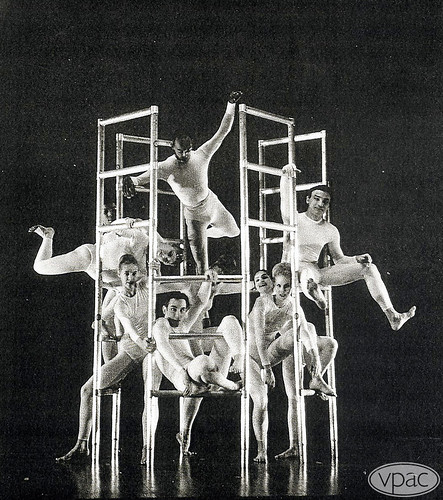
Decentralization was the idea upon which all of Nikolais’s productions were based beginning in 1953 with his work Masks, Props, and Mobiles. Decentralization was built around the ability to change what was the center of the body through the use of “…improvisation and a technical approach to movement that included fluidity of mind, imagery, and response”. According to Nikolais’s beliefs, movement does not come from one internal emotional place, but it can emanate from many different ideas and spaces inside the human psyche. “For a decentralized dancer there is no single point of initiation. She/he attends to articulating joints; peripheral designs of body parts, points, lines, and volumes in space; dynamic textures; and qualifiers of motion identified by physics. Centered motivation tends towards the emotional; decentralized execution is intellectually commanded”. Decentralization was utilized as both a tool for the choreographic process and to train the dancers who came through Nikolais’s various classes. Nikolais wrote that with decentralization “one could now place the origin of force in or on any surface of the body, even a pinpoint of flesh. The concept quickly developed a new potential for nuance in motional expression”. Movement no longer came, for example, exclusively from the solar plexus as had been proposed by concert dance pioneer Isadora Duncan; it could be initiated by the 30 hip, foot, elbow, or right thumb. Nikolais believed that this expanded the possibilities of motion in addition to allowing a greater freedom in how movement was executed by the dancer. The dancer was permitted to shine through the movement, rather than assume another identity through acting. Decentralization epitomized the abstract nature of Nikolais’s productions. By removing the character, the meaning had to come from the movement alone. There was not a story for the audience to focus upon—instead they had to analyze the action on stage and come to their own conclusions.
This concept is especially interesting to me because I am a psychology major and focus a lot of my work on social psychology. One of the ideas in social psychology is decentralization; it is when a person removes himself/herself from his/her original characteristic and takes on the form of another personality because they do not have to associate with their own identity anymore. For instance, if you are wearing a mask, you would be more inclined to do something you wouldn't normally do because no one would know it was you.
ReplyDeleteIn my opinion, Nikolais was unique among his peers in that he was responsible for the complete production of his work, not just the choreography. He was fascinated by decentralization, and in many of his works the body was indistinguishable from its surrounding environment.
ReplyDeleteThe concept of decentralization at the physical level 'pin point of skin' is fascinating to consider as a dancer and teacher, how to bring awareness and expression to ANY place in the body?
ReplyDelete